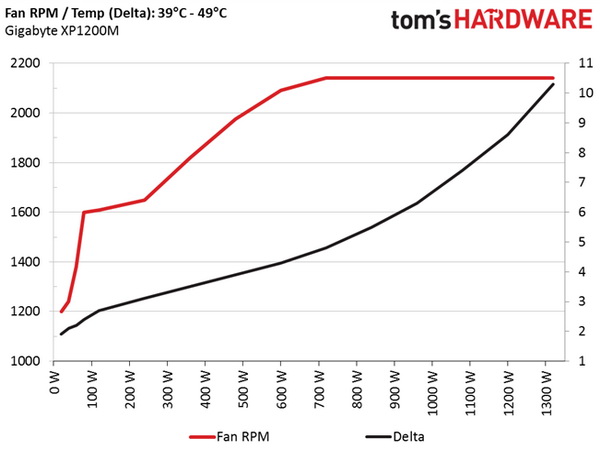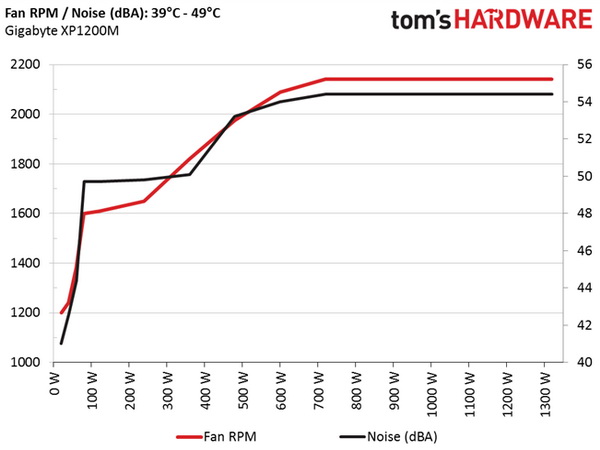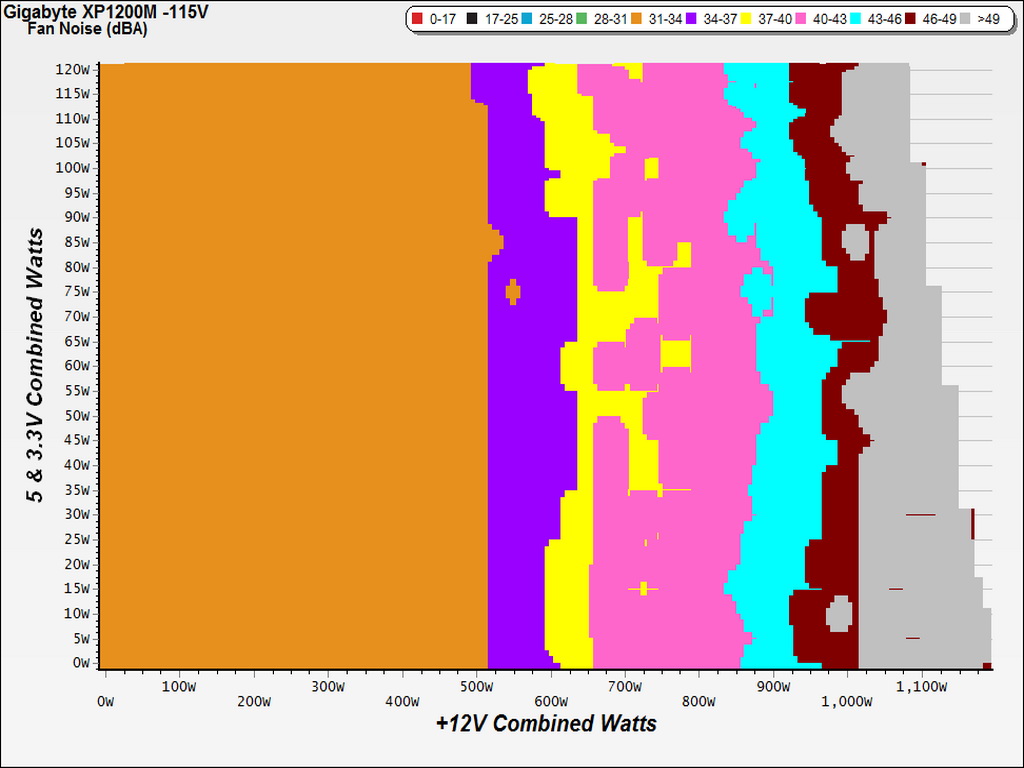Gigabyte Xtreme Gaming 1200 W PSU Review
Gigabytes re-enters the high-end PSU market with its Xtreme Gaming 1200 W PSU. Besides high capacity, it also features Platinum-rated efficiency, modular cables, and interesting looks. This unit is built to meet the demands of enthusiasts, to be sure.
Why you can trust Tom's Hardware
Efficiency, Temperature & Noise
Efficiency
Our efficiency testing procedure is detailed here.
Using the results from the previous page, we plotted a chart showing the XP1200M's efficiency at low loads, and loads from 10 to 110 percent of its maximum-rated capacity.
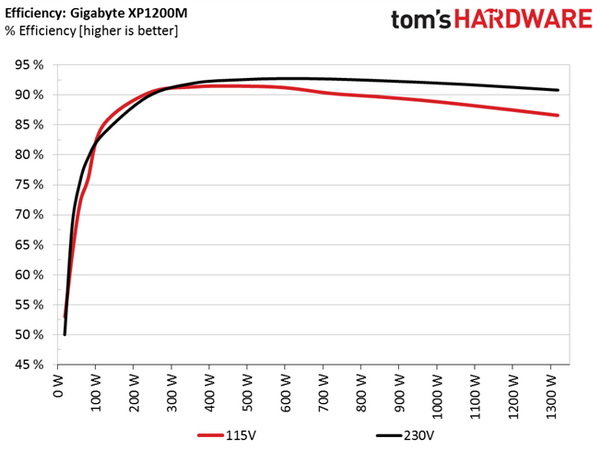
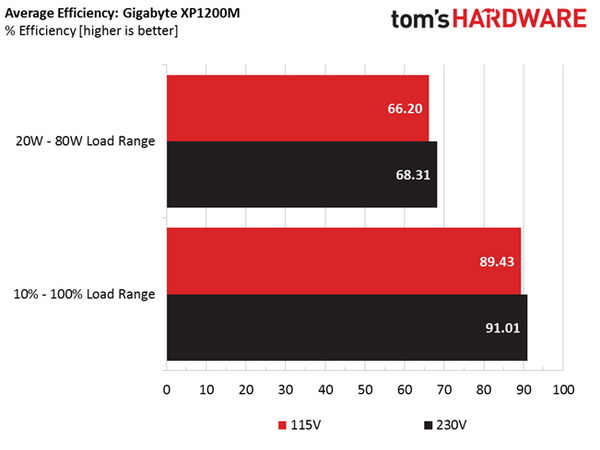
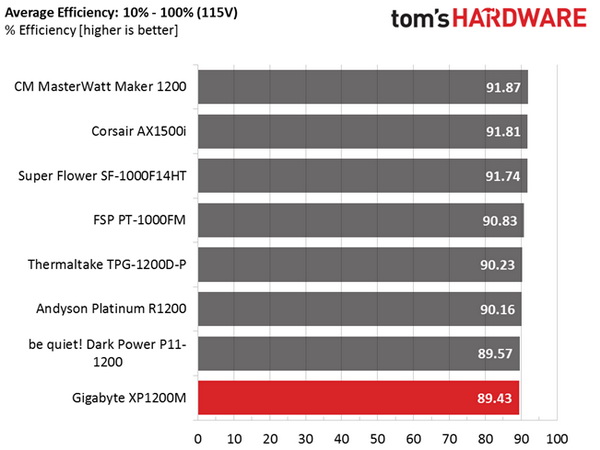

Compared to other similar-capacity Platinum-rated power supplies, the XP1200M's efficiency looks low, especially under light loads. Enhance should at least figure out how to improve its platform's efficiency at those levels.
Efficiency At Low Loads
In the following tests, we measure the XP1200M's efficiency at loads significantly lower than 10 percent of its maximum capacity (the lowest load the 80 PLUS standard measures). The loads we dialed were 20, 40, 60, and 80 W. This is important for representing when a PC is idle, with power-saving features turned on.
| Test # | 12V | 5V | 3.3V | 5VSB | DC/AC (Watts) | Efficiency | Fan Speed | Fan Noise | PF/AC Volts |
|---|---|---|---|---|---|---|---|---|---|
| 1 | 1.177A | 0.503A | 0.479A | 0.200A | 19.60 | 52.96% | 1200 RPM | 41.0 dB(A) | 0.868 |
| 12.326V | 4.987V | 3.320V | 4.982V | 37.01 | 115.2V | ||||
| 2 | 2.390A | 1.001A | 0.994A | 0.398A | 39.71 | 63.91% | 1240 RPM | 42.6 dB(A) | 0.913 |
| 12.322V | 4.982V | 3.317V | 4.974V | 62.13 | 115.1V | ||||
| 3 | 3.601A | 1.498A | 1.506A | 4.968A | 59.78 | 72.10% | 1380 RPM | 44.4 dB(A) | 0.938 |
| 12.318V | 4.977V | 3.315V | 4.968V | 82.91 | 115.1V | ||||
| 4 | 4.806A | 2.015A | 1.989A | 0.805A | 79.79 | 75.83% | 1600 RPM | 49.7 dB(A) | 0.947 |
| 12.315V | 4.974V | 3.313V | 4.960V | 105.22 | 115.1V |
Under 20 W of load, the PSU registers very low efficiency. Unfortunately, that's also true in the other three tests, as efficiency fails to exceed the 80% mark even with 80 W load. To make things worse, the fan spins fast despite the low load levels, making lots of noise. Although the ambient temperature is above 39 °C during these tests, that shouldn't be a problem given how little load we're applying.
5VSB Efficiency
The ATX specification states that 5VSB standby supply efficiency should be as high as possible, recommending 50 percent or higher with 100 mA of load, 60 percent or higher with 250 mA of load, and 70 percent or higher with 1 A or more of load.
We take four measurements: one each at 100, 250, and 1000 mA, and one with the full load the 5VSB rail can handle.
Get Tom's Hardware's best news and in-depth reviews, straight to your inbox.
| Test # | 5VSB | DC/AC (Watts) | Efficiency | PF/AC Volts |
|---|---|---|---|---|
| 1 | 0.101A | 0.50 | 70.42% | 0.048 |
| 4.937V | 0.71 | 115.2V | ||
| 2 | 0.251A | 1.24 | 71.68% | 0.112 |
| 4.934V | 1.73 | 115.2V | ||
| 3 | 1.001A | 4.92 | 82.55% | 0.299 |
| 4.915V | 5.96 | 115.2V | ||
| 4 | 2.501A | 12.20 | 80.16% | 0.454 |
| 4.879V | 15.22 | 115.2V |
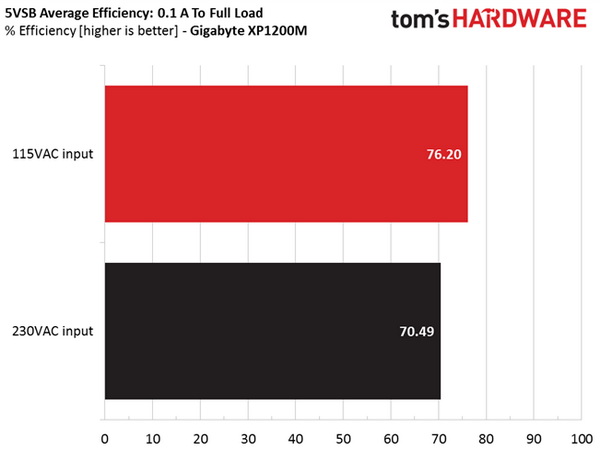

The 5VSB rail registers high efficiency. This is a nice surprise, given the unit's average performance so far.
Power Consumption In Idle And Standby
In the table below, you'll find the power consumption and voltage values of all rails (except -12V) when the PSU is idle (powered on, but without any load on its rails), and the power consumption when the PSU is in standby mode (without any load, at 5VSB).
| Mode | 12V | 5V | 3.3V | 5VSB | Watts | PF/AC Volts |
|---|---|---|---|---|---|---|
| Idle | 12.334V | 4.992V | 3.324V | 4.992V | 20.43 | 0.765 |
| 115.2V | ||||||
| Standby | 0.08 | 0.005 | ||||
| 115.2V |
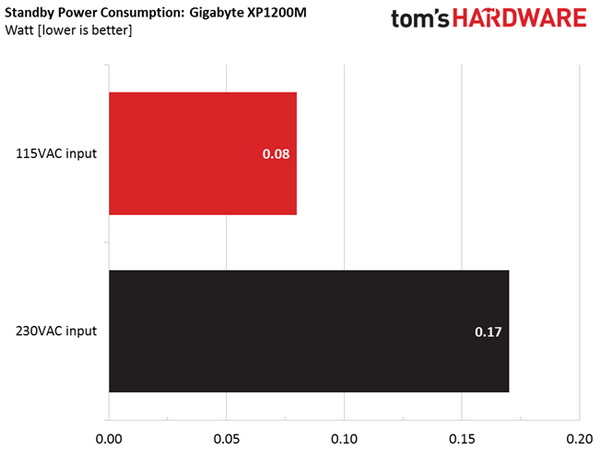
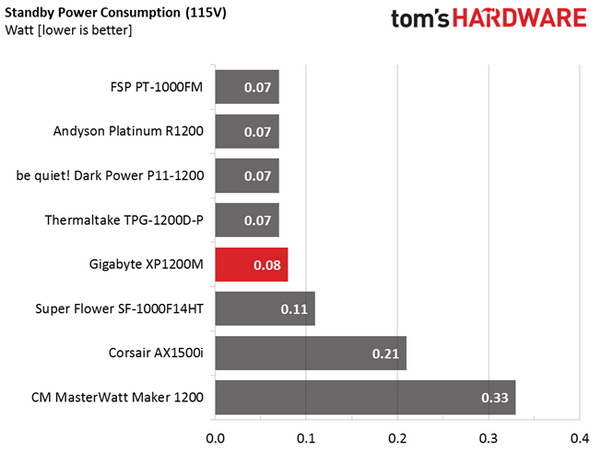
Vampire power is low in both cases, with 115 V and 230 V input.
Fan RPM, Delta Temperature And Output Noise
Our mixed noise testing is described in detail here.
The first chart below illustrates the cooling fan's speed (in RPM), and the delta between input and output temperature. The results were obtained at 39 °C (102.2 °F) to 49 °C (120.2 °F) ambient temperature.
The next chart shows the cooling fan's speed (again, in RPM) and output noise. We measured acoustics from one meter away, inside a small, custom-made anechoic chamber with internals completely covered in sound-proofing material (be quiet! Noise Absorber kit). Background noise inside the chamber was below 18 dB(A) during testing, and the results were obtained with the PSU operating at 39 °C (102.2 °F) to 49 °C (120.2 °F) ambient temperature.
The following graph illustrates the fan's output noise over the PSU's operating range. The same conditions of the above graph apply to our measurements, though the ambient temperature was between at 28 °C (82.4 °F) to 30 °C (86 °F).
Under normal ambient temperatures, the PSU's fan is audible up to 500 W load, and at higher than 650 W the noise exceeds 40 dB(A). That's an annoying amount of noise to sensitive users. With greater than 1 kW loads, the fan's noise exceeds 49 dB(A), annoying most folks.
Current page: Efficiency, Temperature & Noise
Prev Page Load Regulation, Hold-Up Time, And Inrush Current Next Page Protection Features
Aris Mpitziopoulos is a contributing editor at Tom's Hardware, covering PSUs.
-
turkey3_scratch Yawn. It's loud. Might not be too loud in most people's cases where the unit is sucking cool air from underneath the computer, and where they overestimate their power requirements, but it's still way too loud. If they're going to make the fan that aggressive, they should give it a longer warranty. Give it an ol' 11 year warranty to beat the competition at least.Reply
The only way Gigabyte is going to sell this at whatever price is if they do some marketing. "Nvidia Gigabyte GPUs work best with Gigabyte PSU" and people will buy it. -
powernod Enhance continoues its mediocre performance!!Reply
The only series i can remember, in which Enhance showed some very good results were the Thermaltake's GRAND Platinum line.
Besides that,..... just mediocre !! -
Vorador2 When i saw that it used the word "xtreme" (ugh) and "gaming" together in the name of the product i knew it was going to be either overpriced or underperforming. Or both.Reply -
Sam Hain In the 1.2kw range... The EVGA SuperNOVA 1200 P2 is a great buy @$230 (or so), awesome specs and performance across-the-board and some of the highest customer ratings to back it's build quality.Reply
